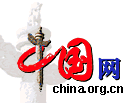|
Major textile companies and organizations said a mechanism to control export prices should be set up to prevent malicious price competition after quotas are removed in 2005.
"We should find a floor price for exports," said Xu Xiaochuan from the Sichuan Xinlixin Textile Company, which is suffering from declining prices.
He expected some Chinese companies to export more by lowering prices after the quota barring the textile flow is eliminated in 2005.
"A mechanism to help the voluntary limit on prices is important for us," he said.
He said the falling prices of China's textile and garment exports are harming the industry's profits.
Export prices of clothing have dropped by about 30 percent since five years ago.
Prices of shuttle-woven garments fell by 27 percent, and those of knitwear by 33 percent, according to Xu.
A senior official from the China Chamber of Commerce of Import and Export for Textiles echoed Xu, saying malicious price competition should be stopped because it merely invited international criticism and trade protectionism that would target the whole Chinese industry.
Some 90 textile trade associations around the world have been campaigning for months to have the WTO consider delaying quota eliminations, saying cheap Chinese textiles will sweep the world.
Under the Agreement on Textiles and Clothing (ATC), all quotas restricting textiles and clothing trade between World Trade Organization (WTO) members will be eliminated by December 31, 2004.
Though their wording is sensational and governments in the United States, European Union and Canada all made it clear they would remove the quota, the official said some Chinese textile exporters should watch their behaviour.
There are signs that some countries will use other methods, such as safeguards, to bar a free flow of textiles.
The mechanism is useful and price agreements is a practice often used by powerful foreign industrial associations, he said.
But the official, who refused to be named because the topic is so sensitive, said the mechanism was new to China.
He said his chamber is studying whether and how to build up the mechanism with some big textile companies.
His chamber is the largest organization in the field in China, with more than 4,000 members.
"It is complicated. We should be careful with it in case someone accuses us of price manipulation," he said.
He said the non-government mechanism should set a bottom price which could generate acceptable profits, which they can use for research and development.
It is widely agreed that the disorder in price competition hinders the industry's development.
Many textile manufacturers still depend too much on their advantages with low labour cost, but forget to develop work efficiency, brands and technology.
China is also losing its low-price advantage to developing countries, which are rapidly developing their own textile industries.
To push exports up and pull in more foreign currency, many domestic companies run down their export business with fierce price cutting as they get more freedom with the gradual lifting of quota limits.
"I think the enterprises should make changes for their own benefit," the official said.
A recent WTO report concluded that other developing countries are catching up with China in terms of unit labor costs in the textile and clothing sector, and China has as yet not shown competitive strength in the design and fashion segments of the markets.
China's total sales revenue in the textile and clothing sector is forecast to reach 1.35 trillion yuan (US$163 million) in 2004, up about 30 percent, and total profits are expected to reach 38 billion yuan (US$4.6 billion), up about 5 percent.
(China Daily August 23, 2004)
|

